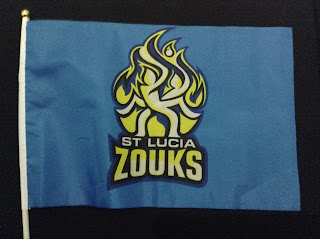The Beausejour Cricket Grounds are near Gros Islet, and seats over 12,000 spectators. The crowds get into the cheerleaders, doing the wave, watching the “jumbotron,” and rooting for the home team. The St. Lucia team nickname is the Zouks, which I think has something to do with music and dancing. Their colors are the same as the national flag of St. Lucia.
The free Zouks flag that I got at the game.
I still have a lot to learn about cricket, and so it is a bit silly for me to try and describe it to someone else given my limited knowledge. It is a bit like baseball with only two bases. The pitcher doesn't have a pitchers mound, but instead lines up behind the opposite base (remember, there are only two bases—which are actually known as wickets), runs toward the wicket, and unleashes a fast pitch towards the other wicket. Unlike in baseball, this is a pitch that bounces off the ground.
The batter standing at the other wicket is trying to protect his wicket from being hit by the pitch, and tries to bat it out of the park to attain the most points (an automatic six points if it goes over the wall). If he gets a hit, he and his teammate over at the opposite wicket run back and forth to each others wickets. They must coordinate their decision as to whether they are going to try for another run or not, because one of them can't run to the other base unless the teammate has vacated it. The distance between the two wickets seems to be about the same (or maybe shorter?) than the distance between bases on a baseball field.
Look close and you can see the two Jamaican players standing at their wickets with gold pants and green jerseys. The refs wear black pants and orange shirts.
The field is shaped like a circle, with the two wickets in the middle. Outfielders are spaced around the circle to get any batted balls and throw the runners out. Catching a ball is an automatic out, just like in baseball, but I think the fielders can simply throw the ball at the wicket to make an out on a runner—there isn't any need for a baseman to tag the runner out. [Obviously, I'm not an expert on this yet.]
In traditional cricket, I've heard that games can go on for days. However, CPL has made some changes to make the game more suited to spectators and television audiences (by the way, the producers for CPL televised games is IMG Sports, the same company that handles WVU Mountaineer sports, as well as most other collegiate teams).
There is only one inning, and a coin flip determines who goes first. That team (which was St. Lucia on the day we were there) goes first and tries to accumulate as many points as possible. Once they are done, the bar is set for what the second team must achieve in order to win the game. The scoreboard counts down the dwindling lead from the first half. The game is over as soon as the second team to bat either exceeds the amount established in the first half, or ends up committing too many outs and thus preventing them from getting enough runs to take the lead and the victory.
On the day we attended, there was a huge crowd at the gates trying to buy tickets. Apparently, the computerized ticketing software was having problems, which caused a big snafu, with many people (including us) missing the entire first half. Even though we had to wait for an hour and a half to get in, we didn't gripe much. One of us took all the money and stood in the line (thanks, Max!) while the rest of us talked together, people-watched, played cards, etc. Since our bus driver wasn't going to meet us until after the game, we didn't have another choice, so we just made the best of the situation.
The stadium is pretty nice. Thankfully it didn't rain that day.
Eventually, we got inside the stadium. We got to see the Jamaican team continue to whittle down the lead that St. Lucia had put up in the first half which we had missed (if you are going to miss a half of a cricket game, be sure to miss the first half—the real drama comes in the second half when seeing if the second team can catch and surpass the first team's score). Unfortunately for the home team, Jamaica ended up scoring enough to win the game.
Although we missed most of the game, we still had a good time. We didn't leave as soon as the game was over, but instead hung out together in the stands talking for awhile. When we finally left our seats and began walking out, we discovered that they were letting anyone go out and walk on the field. We had a great time walking under the bright lights into the middle of the playing surface along with some other spectators who had stayed.
Enjoying our time on the field! [And by wearing a WV shirt, I met a newlywed couple here on their honeymoon from Oak Hill, WV.]
Even though I still have a lot to learn about the game of cricket, I enjoyed spending the time with my amazing colleagues as we continue to sample the Caribbean culture. In the meantime, I hope to brush up on my cricket rules before I go watch another!
A selfie on the field with the big St. Lucia logo.





No comments:
Post a Comment